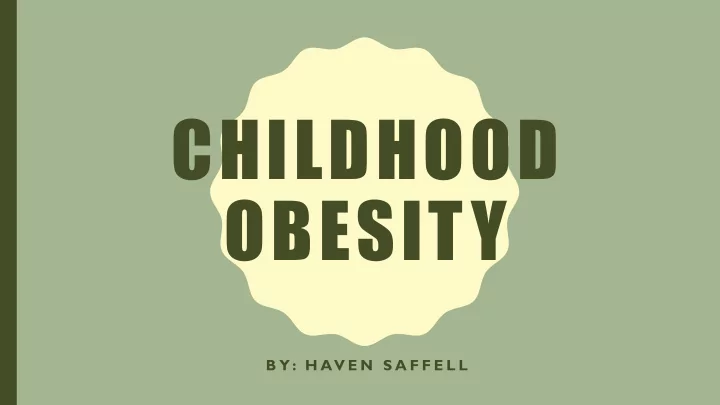

CHILDHOOD OBESITY B Y : H AV E N S A F F E L L
WHAT IS CHILDHOOD OBESITY? • Childhood obesity is a serious medical condition that affects adolescents and which their weight is over the normal for his or her age and height. • Childhood obesity has become a very serious problem in the United States. Unfortunately, it puts children at risk for long term health problems.
HEALTH CONCERNS • Childhood obesity causes many health conditions for children. As you can see in the picture to the left, it breaks down each body region and the concerns obesity causes. Childhood obesity is a very serious matter.
STATISTICS ABOUT CHILDHOOD OBESITY • Childhood obesity can be more common among certain ethnicities. • This medical condition affects about 12.7 millions children in the United States. • In 2011-2014, Hispanics (21.9%) and non-Hispanics blacks (19.5%) showed a higher prevalence than non-Hispanics whites (14.7%). • Non-Hispanic Asian (8.6%) children showed the lowest prevalence for childhood obesity.
CYCLE OF CHILDHOOD OBESITY • Healthy Child a) Television, video games, high fat foods b) Little movement • Mild Obesity a) With poor eating habits and less exercise, the child gains an extra ten pounds. • Moderately Obesity a) If he or she continues to make those choices, more weight (20-50 pounds) will be added. b) Exercise becomes uncomfortable and painful. • Severely Obesity a) Asthma, Diabetes, Musculoskeletal Disease, Depression, Low Esteem, • Obese Adult a) Coronary Artery Disease, Diabetes, Pulmonary Disease, high medical bills.
CONTRIBUTORS TO CHILDHOOD OBESITY • Food choices a) high calories b) high fats c) minimum fruits and vegetables • Parental obesity – Children of obese parents are at risk of being overweight themselves. There are a number of single gene mutations that are capable of causing severe childhood overweight, however these are rare. • Eating patterns – Skipping meals or failure to maintain a steady eating schedule can cause excessive eating. • Formula Feeding – Some long-term studies have shown breast fed babies prevent excessive weight gain as the child grows. • Low birth weight – <5.5 pounds
CHOOSE ‘ MYPLATE ’ • MyPlate replaced the food pyramid and it shows a better picture of what we should be putting on our plates. • Fill half your plate with fruits and vegetables, slightly more vegetables than fruits. • The other half of your plate should be filled with lean protein and grains (brown rice), with slightly more grains than protein. • Make sure you are getting Dairy in your daily diet also. • choosemyplate.gov has great information and helpful tips!
PARENTS • It is important to encourage healthy eating habits. Provide your child with the correct amount of vegetables, fruits, and whole grains he/she needs. a) Make a change to low-fat or non-fat dairy products. b) Choose lean beef, poultry, fish, and beans for protein. c) Serve reasonably sized portions. • Encourage your family to drink lots of water. • Limit or cut out sugar-sweetened drinks.
CONSEQUENCES OF CHILDHOOD OBESITY PSYCHOLOGICAL OUTCOMES HEALTH RISKS • Low self-esteem • Type 2 Diabetes • Depression symptoms • Asthma • Eating disorders • Sleep Apnea • Behavior problems • Hypertension • Learning problems • Low HDL Cholesterol in blood • Poor body image
PHYSICAL ACTIVITY • Children should be involved in 60 minutes of physical activity 5-7 days of the week. For some children this comes easy, for others it is a chore to get them off the couch. Teachers and parents need to learn how to turn their desired physical activities into a fun task. Some examples are listed: Walking/running around the neighborhood Dancing Hide and seek Tag Jumping rope or hula-hooping Swimming Basketball or volleyball Relay races Riding a bike
HELPFUL WEBSITES • Prevention of Childhood Obesity – http://www.nhlbi.nih.gov/health/educational/wecan/about-wecan/background.htm – https://www.health.ny.gov/prevention/nutrition/resources/obparnts.htm – http://www.heart.org/HEARTORG/HealthyLiving/HealthyKids/ChildhoodObesity/Preventing- Childhood-Obesity-Tips-for-Parents-and-Caretakers_UCM_456118_Article.jsp#.WA-Yc4WcHIU • Childhood Obesity – http://www.medicinenet.com/childhood_obesity/article.htm – http://www.obesity.org/resources/facts-about-obesity/childhood-overweight
REFERENCES • http://www.mayoclinic.org/diseases-conditions/childhood-obesity/basics/definition/con- 20027428 • http://www.cdc.gov/obesity/data/childhood.html • https://www.choosemyplate.gov/
Recommend
More recommend